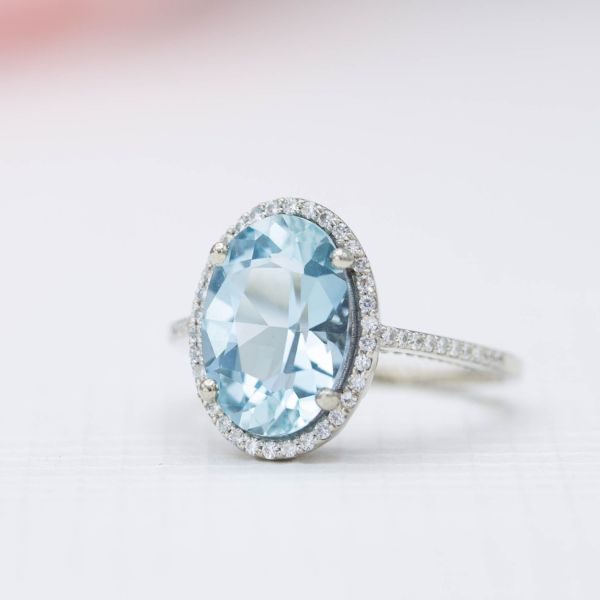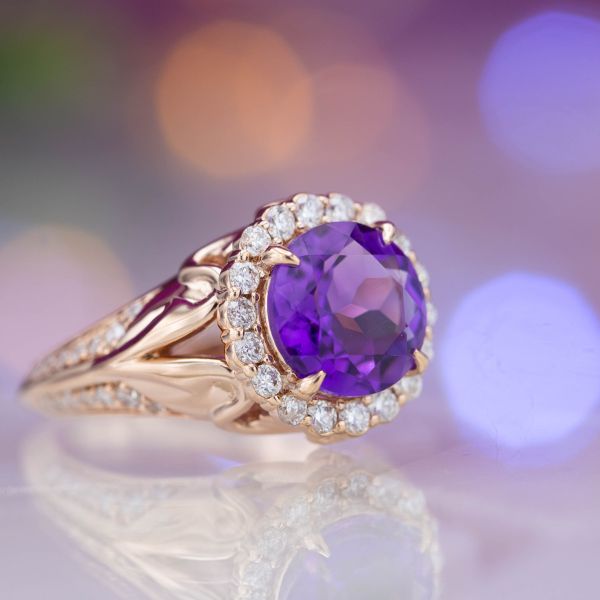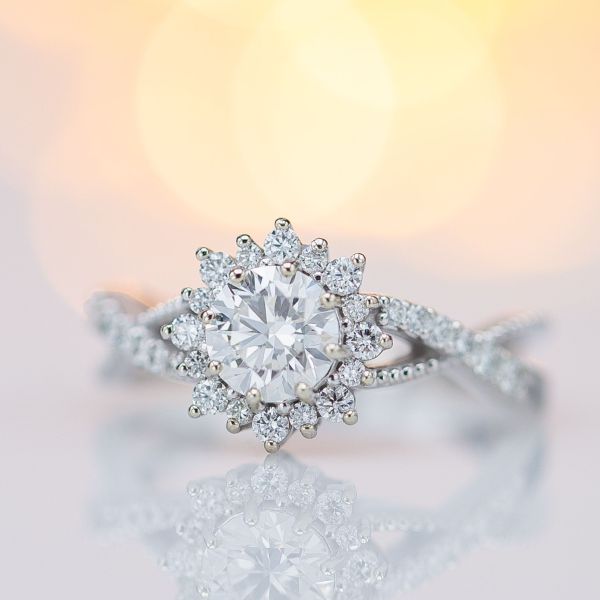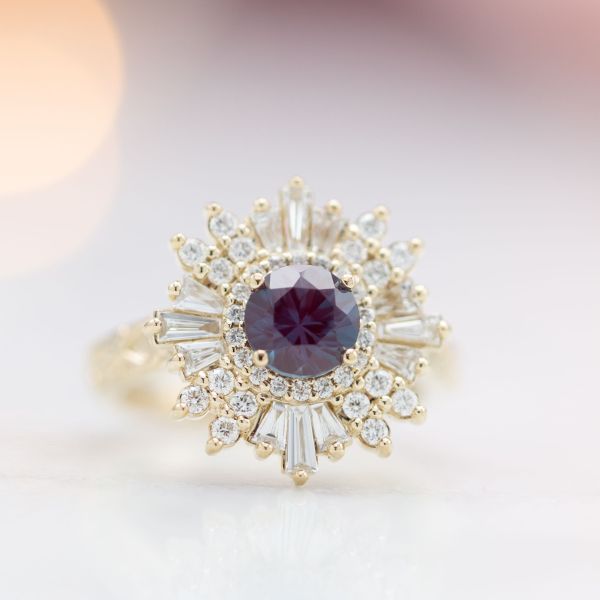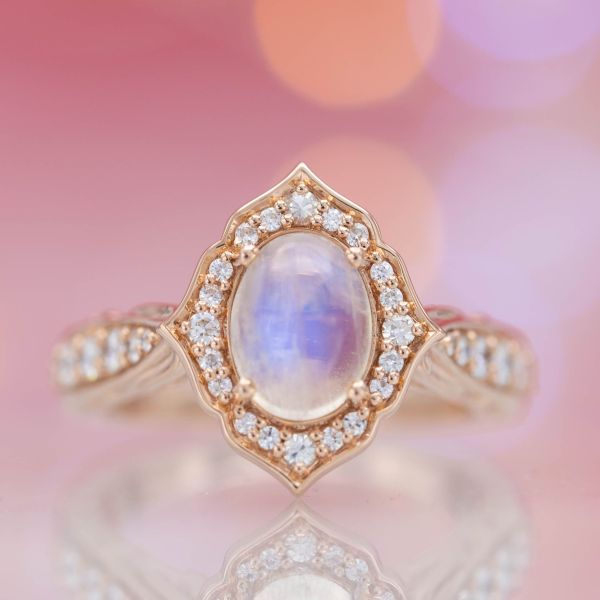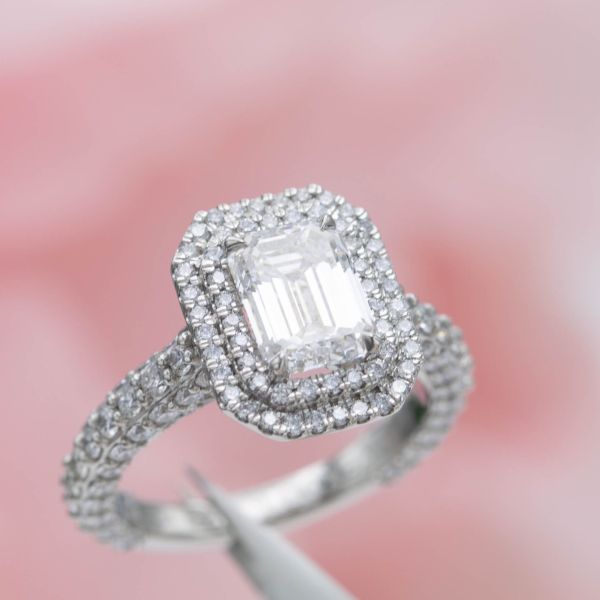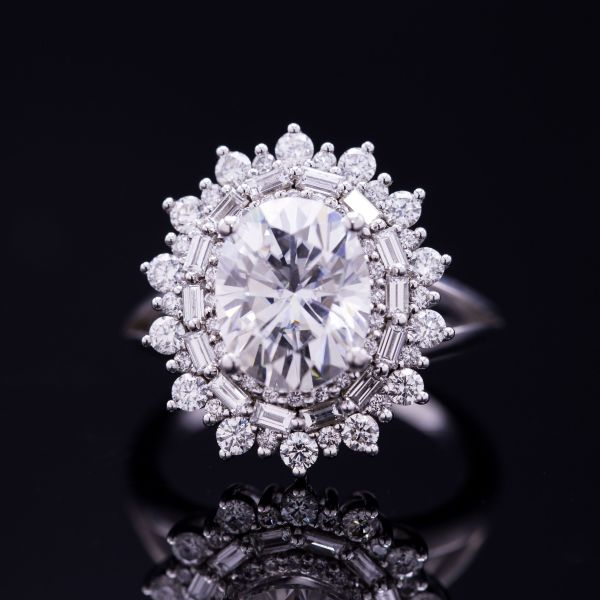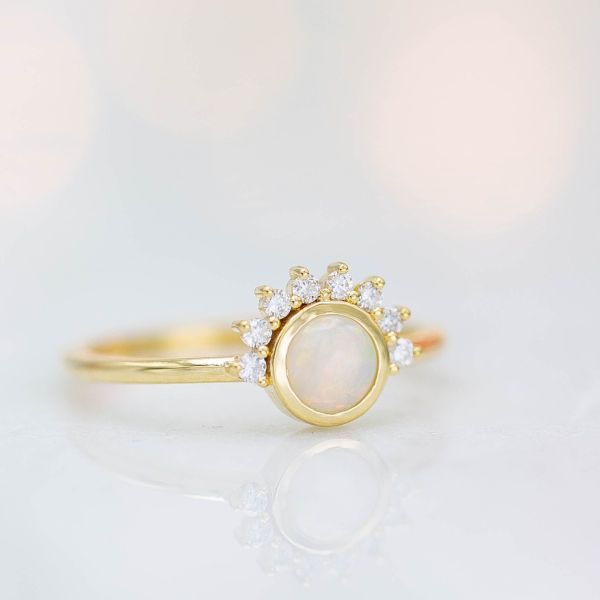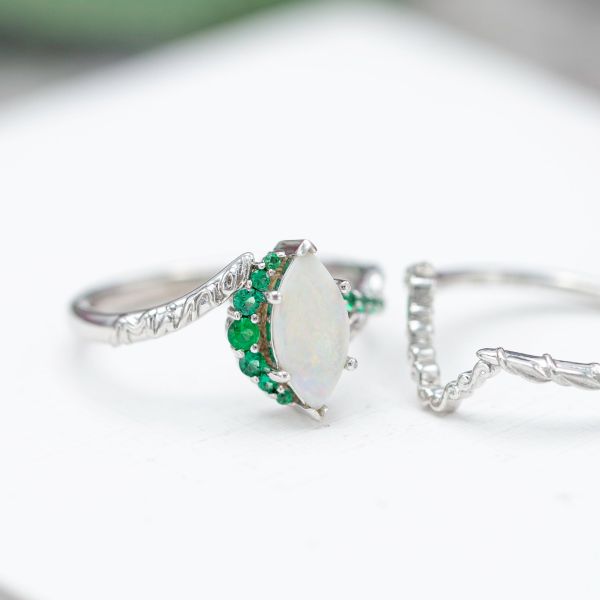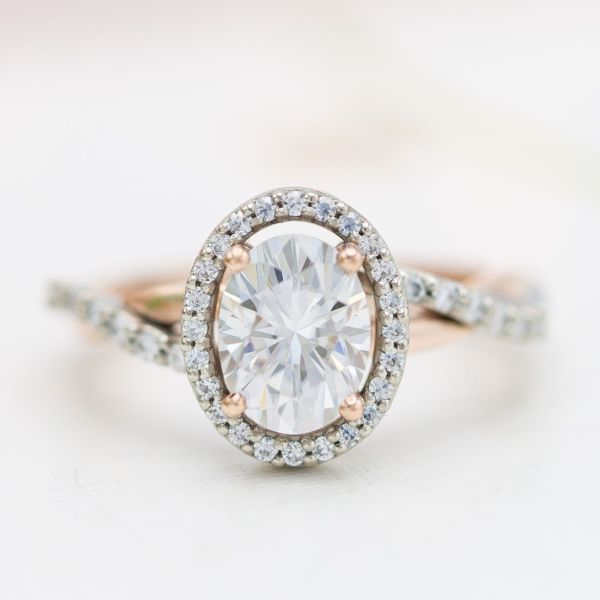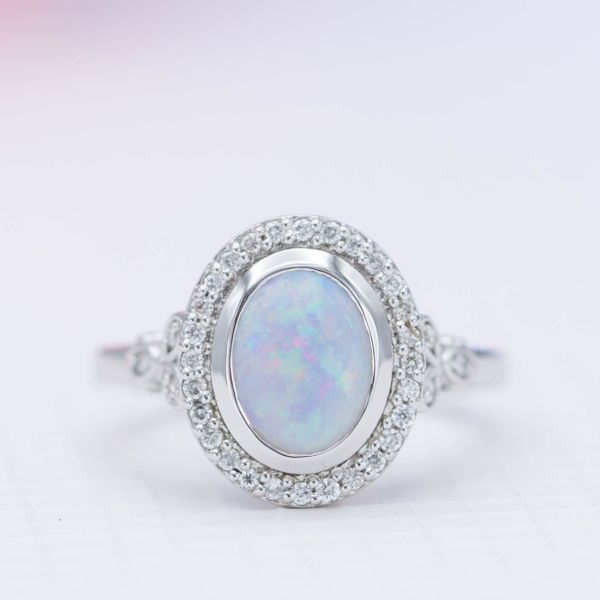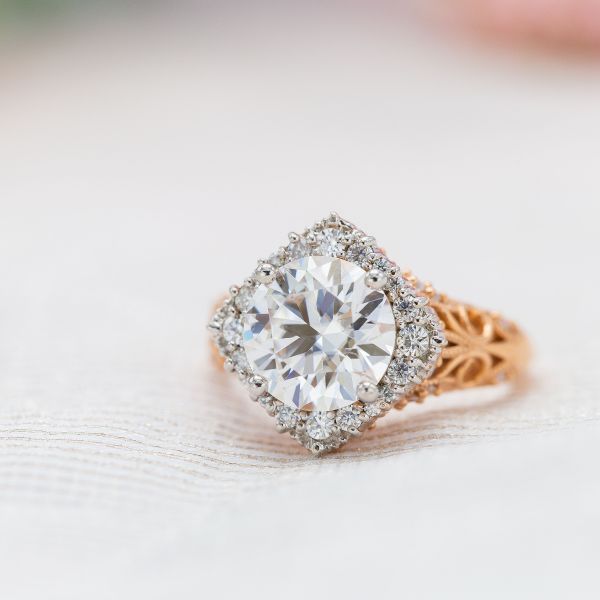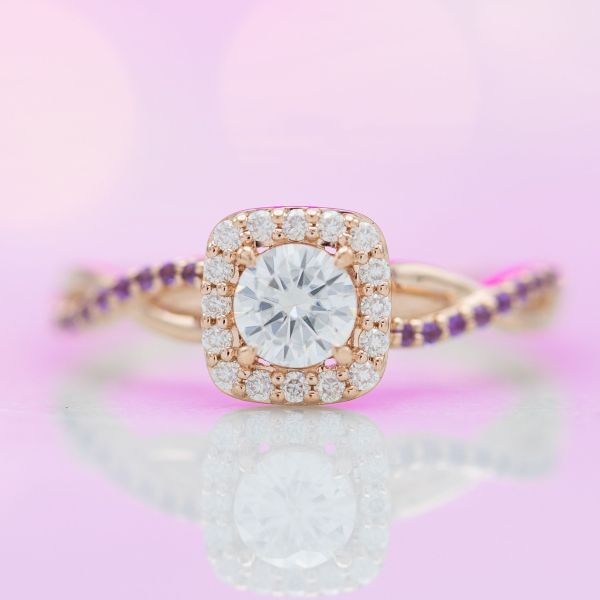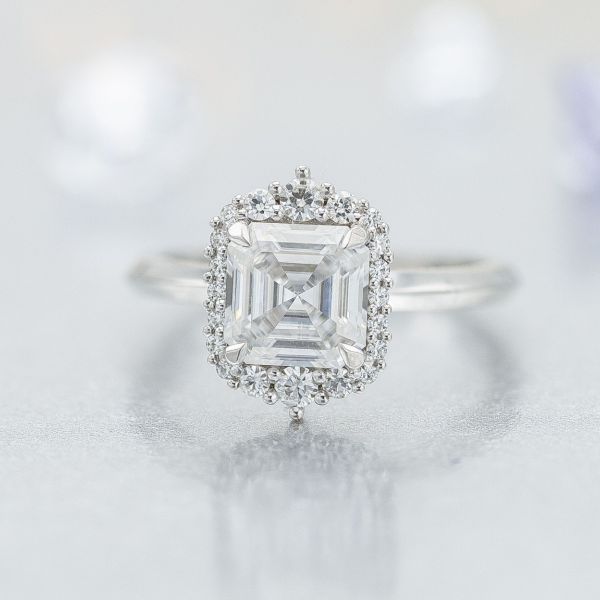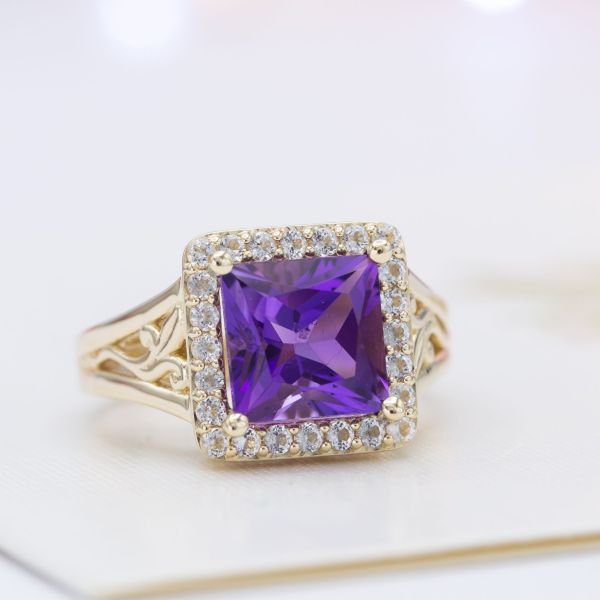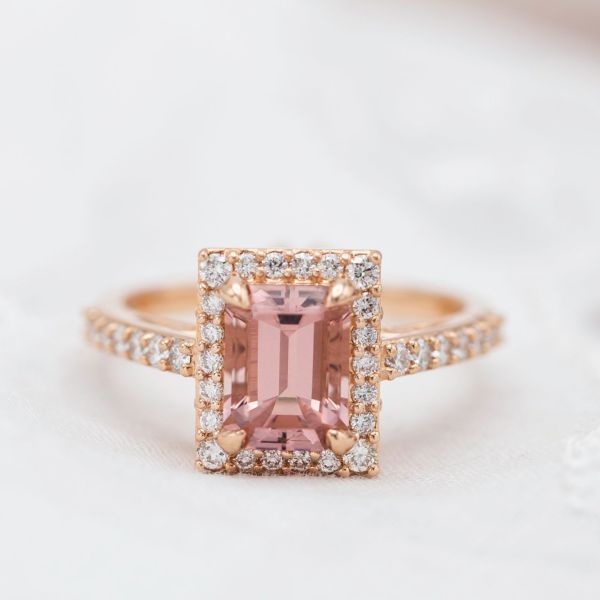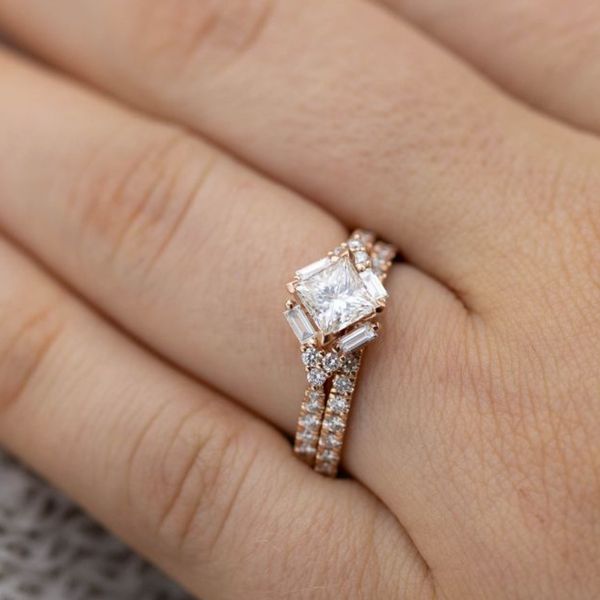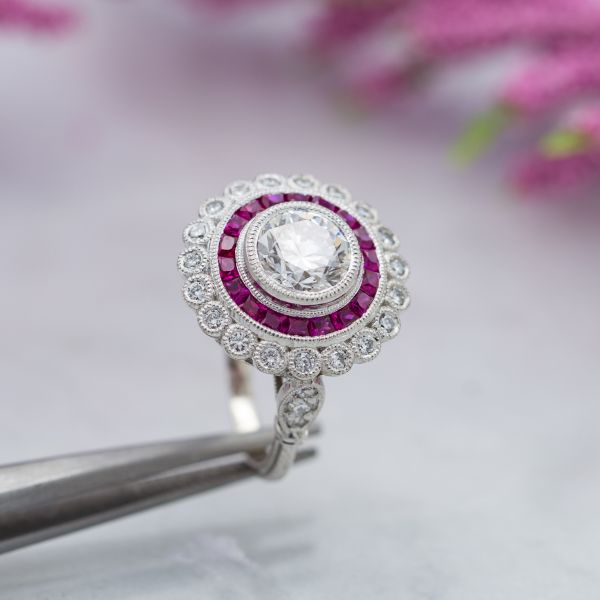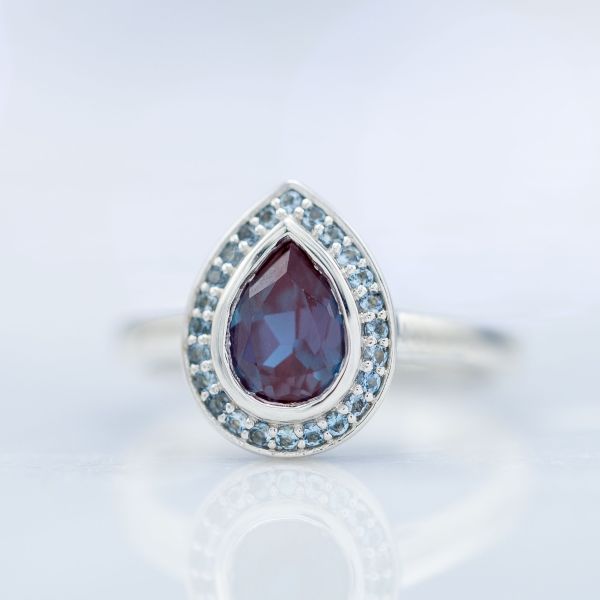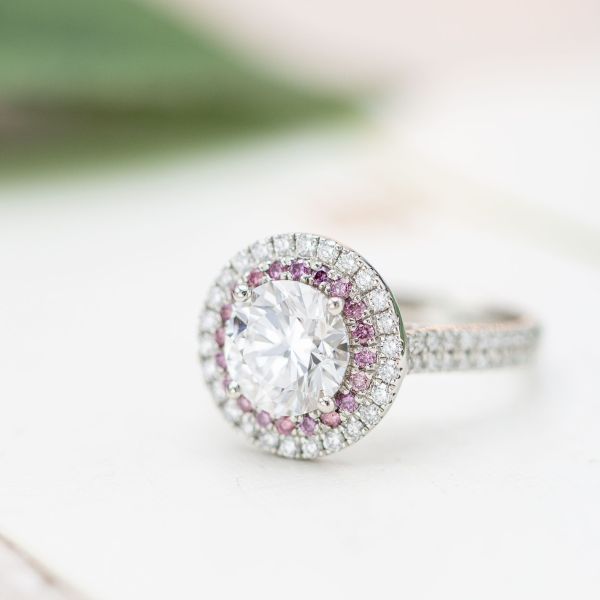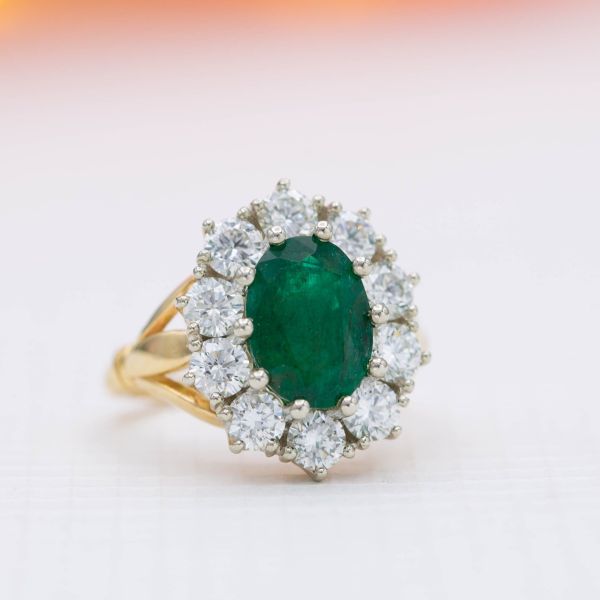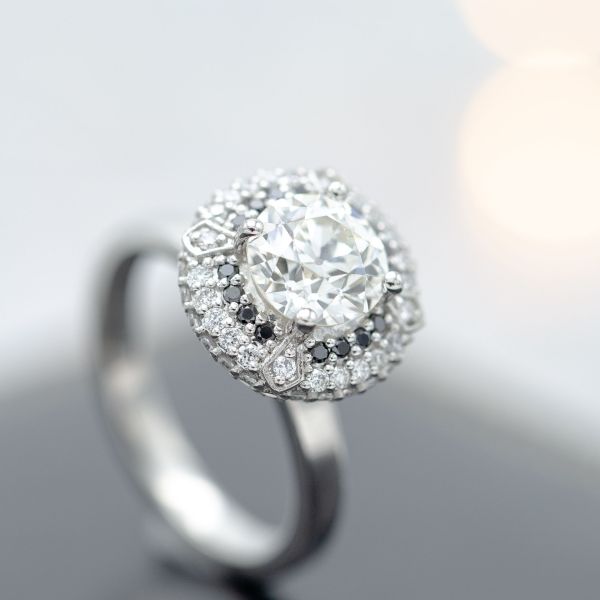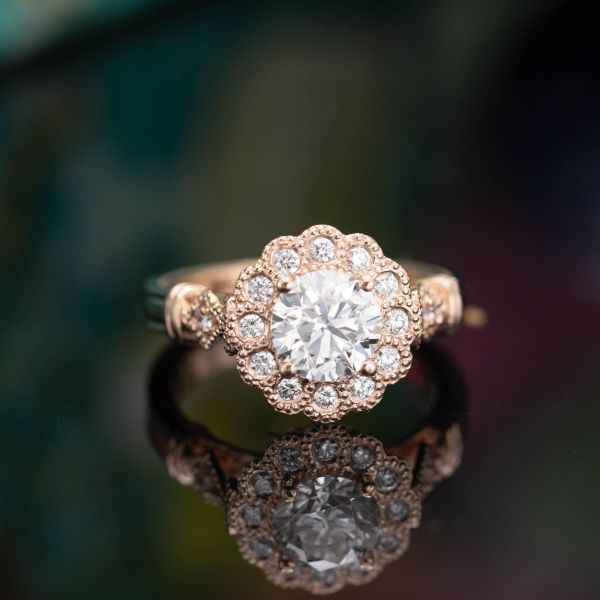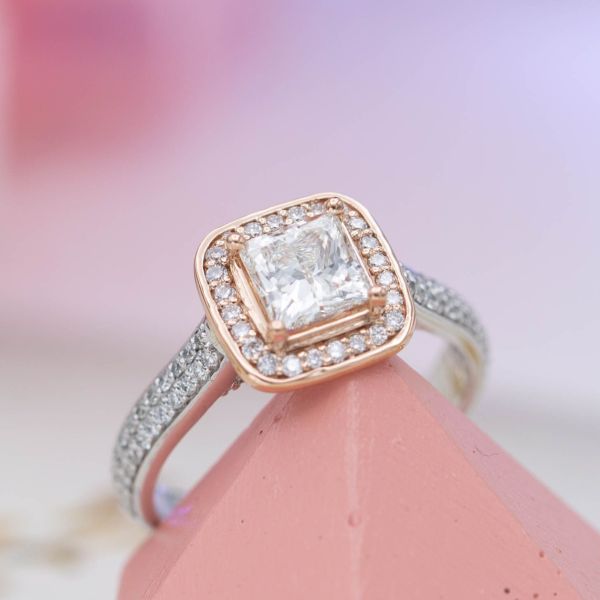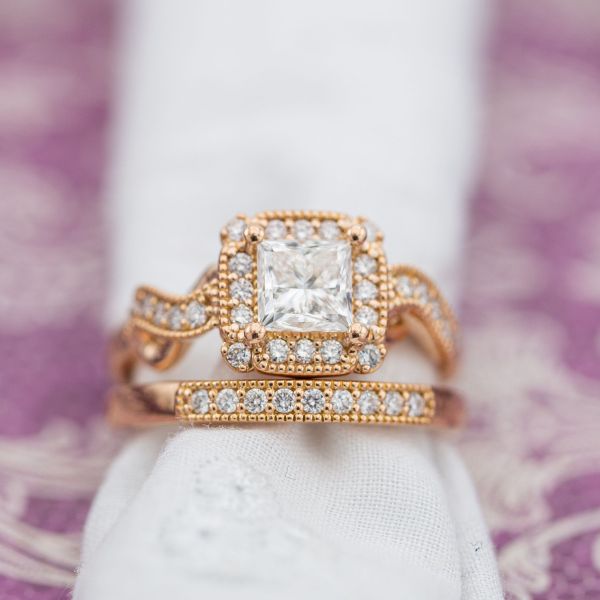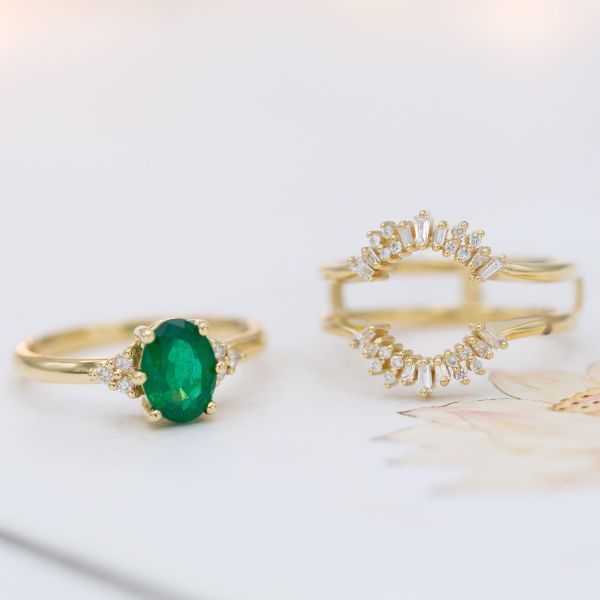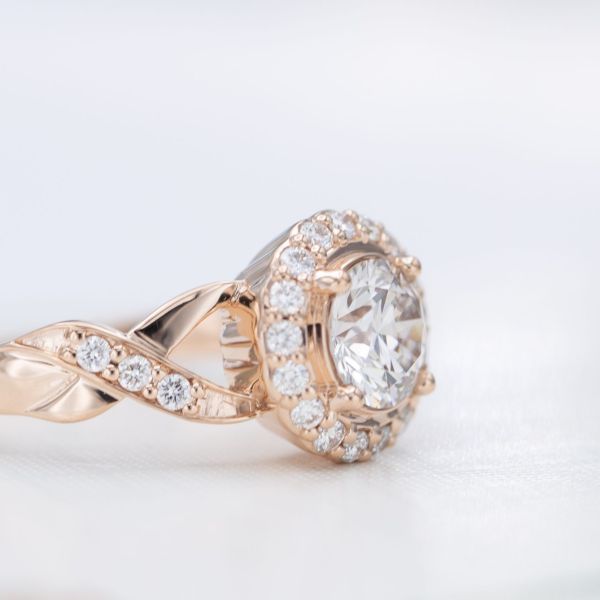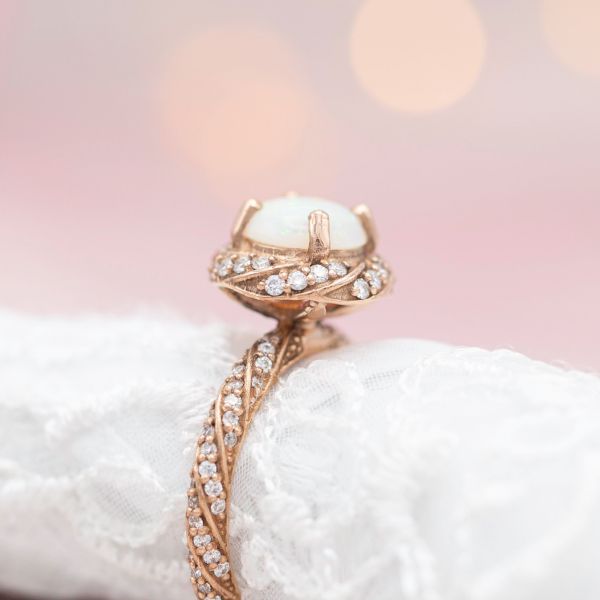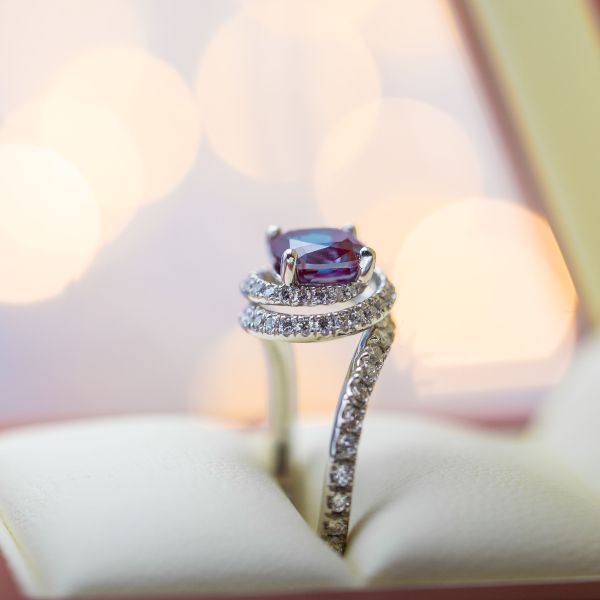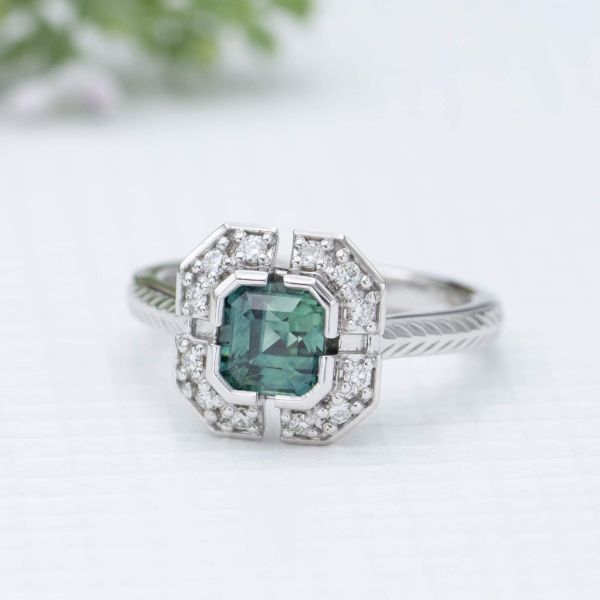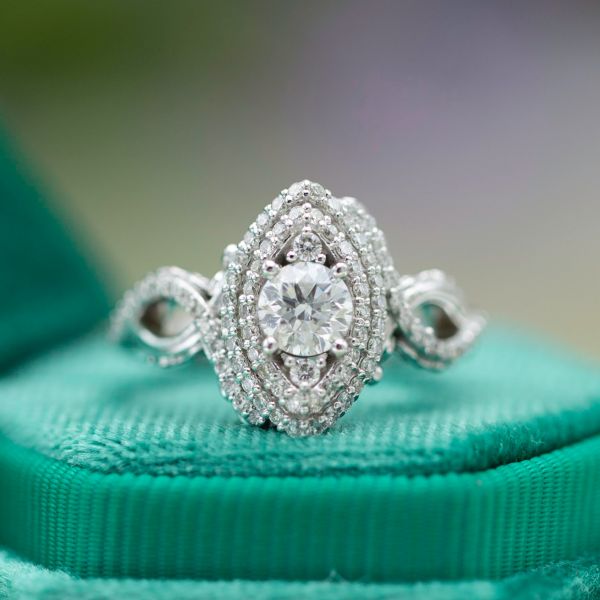Style Knowledge
Halo Engagement Ring Styles
A guide to halo engagement ring styles and design considerations.
Looking to get a little more bling in your ring? A halo-style engagement ring provides a great deal of sparkle that doesn't need to cost an arm and a leg, making it one of the most popular engagement ring settings. But, there are tons of different ways to wear a halo (at least the kind for your finger). This article will guide you through these choices, both big and small, to help you create your perfect custom halo engagement ring.
Choosing a Halo Style
When designing a halo ring, there are few common styles, each with a completely different look. As you read through the descriptions and look at some examples, ask yourself: are you more of a modernist, or do you crave vintage styles? Do you like lots of glam, or a more understated bit of sparkle?
Classic
If you’re thinking of a modern halo ring, you’re probably thinking of a classic halo. In the classic style, the width of the halo metal is the same all the way around the center stone. So, a classic halo doesn’t draw much attention, but still adds a ton of sparkle to the ring. These styles make the center stone appear larger, focusing the eye even more on your ring’s biggest jewel.
Scalloped
In contrast, a scalloped halo has rounded metal around each of the halo’s diamonds or gems. This type of halo softens the ring’s look. With its vintage flair and a floral feel, many fall in love with scalloped halo rings.
Sunburst
Sunburst halos give a somewhat edgier personality to a halo style. You’ll probably recognize this style from Princess Diana’s famous engagement ring (now worn by the Duchess of Cambridge). To create a sunburst halo, we can use two different sizes of diamonds or gemstones, alternating the larger and smaller size stones to create the unique sunburst halo outline. Or, even more simply, we can set one of the prongs for the halo gems on the outside, creating little points at the tip of each accent gem. There are a lot of styling options for this type of halo, so you might be find some inspiration by looking at a few sunburst rings we recently published.
Unlike the classic halo, a sunburst will definitely draw attention. The detailing around the center stone provides an attractive geometry and shines like the sun (or maybe a supernova). A little floral, a little snowflake, and a whole lotta sparkle.
Ballerina
For a bigger statement, the ballerina halo has become increasingly popular over the last few years. This style uses elongated baguette gems extending out from the center stone to create a bold, geometric statement. The gems can be rectangular or tapered baguettes, often alternate lengths, and sometimes mix in rows of rounded or marquise cut accent gems between the baguettes. Like a sunburst halo, the gems are often set with a prong on the outside, so they have some of the same brilliant rays-of-sun sparkle. But the use of elongated rectangular gems gives these halos a distinctive appearance, reminiscent of a ballerina's tutu — hence the name.
The geometry of these designs draws inspiration from Art Deco design, but their recent revival and growing popularity also makes them a very modern choice.
Antique Frame
If you prefer a more subtle vintage style than the sunburst or scalloped halo, you might consider an antique frame halo. We created this term to capture a set of design styles that remind us of beautifully ornate antique picture frames. This style uses small diamonds or gemstones of different sizes and metalwork with ornamental curves and edges. Sometimes, the curves mimic the natural shape of flower petals, with the largest stones set at the tip of each "petal," and the rest of the gems becomes gradually smaller toward the edge. This is a classic form for a vintage-style engagement ring, adding elegant shine like a portrait frame around the center stone. Check out a few of the varied designs we've created in this style in this recent write-up on antique frame halos.
Halo Arrangements
In the most classic looks, a single halo provides an elegant addition to your center stone. But, if you need more bling why not go for two or three rows? Prefer an asymmetric style? We can do that too.
Double Halos
Exactly like they sound, a double halo provides you with twice the ice of a single halo. Like a single halo, double halos can come in all different styles. If you’re looking for a classic and timeless style, your halos will be uniform in width around the stone, featuring small round diamonds or gems.
However, you can mix and match for a different style. Many choose a classic inner halo with an outer halo of a different style. That said, two scalloped halos adds a wonderful, soft texture to the ring, while two sunbursts would look like a flower with layered petals.
Triple Halos
While a triple halo is too much for some, others love the finger coverage it provides. Of course, a triple halo also gives you more options for customization. Some spectacular designs opt for a pop of color in the second halo, giving the ring a completely unique look. Others play with the size and shape of the stones or style of the halo.
Half Halos and Semi-Halos
For some, less is more. With the trend of making wedding bands to perfectly match the engagement ring, some opt for a half-halo. In this arrangement, the halo surrounds the center stone on only one side of the band, leaving the other side bare. Then, a contoured wedding band provides the other half of the halo on your special day.
Others opt for designs that employ semi-halos. These halo arrangements cover a portion of the center stone’s perimeter, but not all of it. For example, in a bypass ring where a diamond-encrusted band passes over the north and south of the center stone would be a semi-halo. Another possibility is a halo in the shape of a crescent moon, where it doesn’t form a full circle.
Floating Halos
Yet another consideration is whether you’d prefer the center stone to sit snug with the halo or “floating” around it. Leaving a bit of space around the center stone can help draw attention to the center stone by separating it from the surrounding halo. It can also help keep a large center setting feeling light and airy, even if the halo makes the overall look larger on the finger.
Take a look at the two examples below. In these designs, we used two very different techniques to give the halo the illusion that it's floating around the center stone. One literally leaves a little gap between the halo and the center stone. The other has a wider metal bezel around the center stone, creating a contrast between the center opal and its diamond halo with the polished white gold of the bezel.
Halo Design Details
Now that you’ve made some of the big decisions, get ready for all those little details. They might seem small, but these choices will get your ring from “It’s beautiful!” to “It’s absolutely perfect!”
Halo Outlines
Most people choose halo outlines that match the shape of their center stone. These always look great, and they provide the perfect complement to the center stone.
However, there are plenty of reasons you might opt for a halo with a different outline than your center stone. For example, round brilliant diamonds provide the most sparkle of any diamond shape. But, some people prefer the gentle outline of a cushion, and place their round diamond in a cushion-cut halo. Others want a sharp and geometric square outline for a round diamond. Still others inherit diamonds, but prefer a different shape outline for their ring.
Of course, you can also use the halo’s outline to create interesting geometric features. One trendy style is a hexagon or octagon halo around a round stone, giving sharp edges to a circular feature. On the other hand, you can place a princess-cut stone in a cushion-shape halo to soften it.
For a square-shaped halo, you’ll have to choose whether you want sharp right angles or cut corners for a softer look. Both styles look great for princess, asscher, radiant, and emerald cuts.
Halo Stone Shapes
In addition to the overall outline, you’ll need to decide on the shape of the stones that make up the halo. You can’t go wrong with the classic round. Most choose round stones for any of the different halo outlines. Still, princess-cut stones look great for geometric styles.
Baguette-shaped stones provide a more subtle sparkle and can be tapered for fascinating designs. Some choose to use baguettes in one row of their double or triple halo rings, while others create the distinctive Art Deco sunburst of a ballerina halo using baguettes.
Finally, calibré-cut stones offer a unique custom experience. Popularized during the Art Deco period, this setting allows you to get a seamless pop of color. These stones are expertly cut to fit next to one another with no gap, and they’re cut specifically for your design. We use a channel setting to hold a calibré-cut halo in place so that they’re secure without prongs. That means you can get a full circle of shiny gemstone without any distractions!
Colored Gemstones and Halo Settings
Considering a colorful design? There are plenty of ways to mix and match colored gemstones with diamond or moissanite.
Colored Gem Center Stone
For a colored gem center stone, a diamond halo is the most popular choice. This option adds a lot of sparkle to the ring and gives it a classic look.
However, that’s not your only option. We can work with you to find the perfect complement to your center stone. Having a matching halo is one option, but using gems with a lighter tone will make your center stone appear larger. Using a different color halo can be trickier, but we’re here to help you find the best combo and make it look great.
You can also use double or triple halos to add both diamonds and gemstones to the design. Or, alternate them in a single halo for a unique look.
White Center Stone
For a diamond or moissanite center, a pop of color in your halo will certainly make your ring stand out from the rest. However, using a halo of dark gems will have the opposite effect of a diamond halo: the center stone will appear somewhat smaller. If that bothers you, though, you could always choose a double halo. Then, the inner diamond halo enhances your center stone while the outer provides that pop of color.
Pastel halos are a another way to add color without making a white center stone look too much smaller. This recent design used an inner halo of pink diamonds, whose pale color creates a soft contrast between the gorgeous diamond center stone and the sparkling diamond outer halo.
Styling a Halo
Are you ready to get into the nitty-gritty? These little styling details can make a big impact on your ring’s overall look. Remember, even in a halo ring, the devil is in the details.
Choosing the Size of Halo Stones
For a halo setting, the size of the stones in your halo is one of these details that makes a big difference. Smaller halo stones offer a dense glitter around your center stone. It’s often impossible to tell where one stops and the next starts, unless you’re looking very closely. These are the best for offering a little more glitter to your ring. Meanwhile, larger stones offer a more vintage look or a chunky geometry.
For scalloped halos, the size of the halo stones makes an even larger difference. Do you want many, small scalloped edges or a few larger ones?
Stone size makes a similar impact on sunburst halos. Larger stones make the sunburst pattern more prominent, while smaller ones look like a small detail at the edge of your center stone.
For double and triple halos, you could of course have different stone sizes in different halos. Choosing different sizes gives the halo a different texture than using a uniform size throughout.
Halo Stone Size vs. Center Stone Size
Of course, you should also consider the size of your center stone when choosing what size halo stones you’d like. If you have a small center stone, larger halo stones may overwhelm it. For larger stones, a small halo will look slim and sleek, and you’ll need larger halo stones to create a chunky look.
Prong-Set vs. Bezel-Set vs. Channel-Set Halos
The way that we set the halo stones makes a difference to its overall look, too. In most halo rings, tiny prongs hold the stones in place. In a custom ring, that’s not your only option. Bezel-set halos are more secure, but there is more metal between the stones, which means that the halo may have just a bit less sparkle. Channel-set halos are a nice middle ground, providing good protection with continuous sparkle.
For a scalloped halo, choosing between prong-set and bezel-set stones gives the ring an entirely different feel. With a prong-set scalloped halo, the scalloping can come entirely from the stone itself. Meanwhile, bezel-set stones have metal surrounding them. This means that each bump of scalloping has the sparkly stone surrounded by metal.
To Milgrain or not to Milgrain?
For vintage styles, that really is the question. Milgrain refers to the tiny metal beads you see as ornamentation in many engagement rings. Often used as a border detail, milgrain gives a ring a great texture. Some halo rings employ milgrain at the outer edge of the halo or between halos for double or triple halo rings. In fact, because of the light shining off of it, milgrain can appear like a halo itself.
Some love the look of milgrain on their scalloped halos, while others prefer sleek, smooth metal. For small, bezel-set stones, milgrain can make these stones appear like larger, chunkier stones.
Color Matching Diamond-on-Diamond Halos
If you’re opting for a diamond center stone with a diamond halo, you’re probably wondering how diamond color should impact your choices. While diamond color does play a role in how your halo ring will look, it’s not a huge consideration. In general, a halo that’s more than two color grades whiter than your diamond can make the diamond look off-color. We’ll make sure that the diamond you choose looks great in its setting, and we’ll try to match the halo stone colors to your diamond.
Matching Wedding Bands for More Halo Action
Wedding bands can literally add to your halo. With so many couples opting for matching, contoured wedding bands, why not add another half-halo to your ring on your wedding day? Some even choose to add a full halo with two wedding bands (or one wedding band and an anniversary band).
To ensure a perfect fit for your contoured wedding band we recommend designing the matching band (or bands!) at the same time as the engagement ring, even if you choose not to buy the matching bands right away.
Other Halo Styles
Of course, as with any feature of ring design, there are always more options to consider. If you haven’t quite found what you’re looking for, you’re not alone. Plenty of our customers work with us to explore and design other halo configurations and styles. Here are a few more styles to help inspire you on your design journey to the perfect halo ring.
Flat vs. Angled Halos
Do you want a flat halo that faces straight up, or one that angles outward? Although most opt for a flat halo best viewed face-on, angled or domed halos offer a more subtle look. They also add to the side profile view of the ring.
Using angled or domed halos for double or triple halo rings also makes their finger coverage a little smaller, an attractive option for those with small fingers or large center stones.
Side Halos
Of course, some halos can face out from the side profile. These will not be visible at all from the top down, but add a nice sparkle that you’ll notice every day. Or, as we did in this design, you can set set diamonds on both the top and side edges of the halo, to make sure there's tons of sparkle from every angle.
Twisting Halos
Twisting halo styles don’t neatly fit into the single, double, and triple categories. Instead, these rings use a twisted pavé rope style. Here, the tiny stones follow twisted lines around your center stone, as if you had a very sparkly rope on your ring.
Some opt for twisted pavé and plain metal rope, giving their halo gaps in between the gems. These can resemble waves of gemstones around your center stone.
Twisting styles give your ring a unique and modern look that’s less ubiquitous than the classic halo. Better yet, this type of halo also adds to the side profile view.
Spiral Halos
Another twist — pun very much intended — on the traditional halo is the spiral halo, which gives the appearance of the band winding around to create a twisting nest for the center stone. A bit like an exaggerated bypass setting, the spiral can be seen from above like a halo, but also adds elegant curves and sparkle when viewed from the side.
Unique Halos
If you’re looking for something entirely unique, you’re not our first. We’re here to make your special design a reality. Check out a handful of uncommon halo designs we’ve made, and visit our recent collection of unique halo designs for more inspiration.
About CustomMade
CustomMade designs and creates one-of-a-kind, custom engagement rings and fine jewelry. Each piece we create is inspired by you, designed for you, and made just for you.
